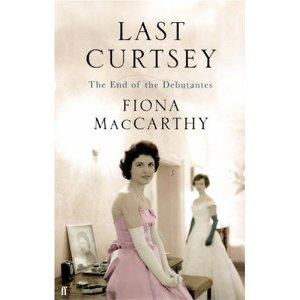To have and to have not

Fiona MacCarthy looks back on the last debutantes' 'Season', in 1958. By Joseph Mahon.
Last Curtsey: The End of the Debutantes by Fiona MacCarthy. Faber and Faber, 2006.
Are the rich very different to the rest of us, or is it just that - as Hemingway insisted – that they have lots more money?
A persuasive answer to this question is that the rich are very different because they are socially constructed to be very different. Literary and social biographies such as Humphrey Carpenter's The Brideshead Generation: Evelyn Waugh and his Friends (1989), and Paula Byrne's Mad World: Evelyn Waugh and the Secrets of Brideshead (2009), give a compelling insight into the construction of class during the inter-war years, while Polly Toynbee's "Inherit and be damned" (Guardian, 5 April, 1988) paints a salutary tale of the burdens of class during the 1980s. For a truly poignant account of the felicities and horizons of class in the post-war era, however, it would be hard to surpass Fiona MacCarthy's widely reviewed Last Curtsey: The End of the Debutantes.
The book gets its title from the historical fact that "In 1958 - the year in which Kruschev came to power in Russia, the year after Eden's resignation over Suez, two years after John Osborne's Look Back in Anger - the last of the debutantes, myself among them, went to the Palace to curtsey to the Queen."
The debutantes were upper-class girls, mostly coming from titled families who owned country estates and town houses in London, some of them large enough to function as venues for the Season's balls. The debs' escorts - the men who were chosen as prospective marriage partners - were known in those circles as "debs' delights," and they were mostly young officers from the Household Brigade regiments.
In addition to the usual markers of class - title, wealth, address and money - there were also sartorial and linguistic signifiers of class. MacCarthy recalls that "There were right clothes and wrong clothes for every occasion: I remember the horror when I proposed arriving in red shoes at a house party in the country. There were right words and wrong words, and the wrong ones would arouse a barely concealed shudder." So, you said pudding rather than sweet, lavatory paper rather than toilet paper, and vegetables rather than greens. Those attending Oxbridge, public schools, and private prep schools still use this terminology assiduously.
The style of the Season - defined by Anthony Sampson in The Anatomy of Britain as "the succession of private dances and balls given between April and July, which serve as the marriage market for richer children" - during the 1950s "was still conservative, fixed in the gracious-lady idiom."
The shopping list, moreover, was long: "A minimum of six dance dresses, of which one must be white for Queen Charlotte's Ball in May. Two or three of the dresses needed to be long and relatively formal, for the grander balls in London; the others could be short, for dances in the country. Debs also needed several day dresses in silk or chiffon, suitable for Ascot, Henley, the Fourth of June at Eton. Further necessities were shoes and gloves and handbags and especially hats in what was not only the year of the last curtsey, but also the year in which the wearing of hats for social occasions was done with a conviction that would not be seen again."
In a Tatler article of April 1958, Lady Listowel gave a detailed breakdown of what a Season actually cost; a money-no-object Season, in today's terms, cost 120,000 pounds sterling.
Just as it became fashionable to proclaim the end of ideology, it has also become fashionable to proclaim the end of class. Fiona MacCarthy herself succumbs to this temptation when she writes: "The debutante Season in its origins was territorial, to do with marriage treaties and the continuity of power through the landowners and monarchy. I was at the tail end of it, as territories dwindled, as housing estates encroached upon old parklands, as great houses were either opened up to the public or divided up and marketed as the most desirable of residences. Live like a lord! The land was all too visibly returning to the people, and the landowners suffered the humiliation."
But the "poshies" haven't gone away. They still own and race horses, they send their children to Marlborough, Cheltenham and Roedean, and they do art history at Cambridge and St. Andrews.
In an article for the April 2005 edition of Tatler, entitled What Kind of Rich are You? Vassi Chamberlain differentiates between the regulation rich, the superficially rich, the ethically rich, the gulfstream rich, the shabby rich and the techno rich. Many of Fiona MacCarthy's upper class families now belong to the ranks of the shabby rich, and are outnumbered by the arrivistes.
Writing in the same issue of Tatler, Natalie Richenberg notes that "You probably aren't rich unless you spend 1 million pounds sterling a year, which is not at all difficult...And we haven't included the purchase price of the thoroughbred..."
